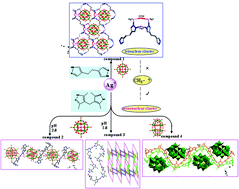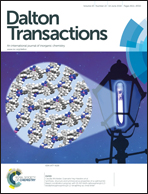The key role of –CH3 steric hindrance in bis(pyrazolyl) ligand on polyoxometalate-based compounds†
Abstract
Through using two kinds of bis(pyrazolyl) ligands, four polyoxometalate (POM)-based compounds were hydrothermally synthesized and structurally characterized, [Ag3(Hbhpe)2(H2O)(H2PMo12O40)]·H2O (1), [Ag(H2bdpm)2(H2PW12O40)]·4H2O (2), [Ag6(H2bdpm)6(HPWVI8WV4O40)]·2H2O (3) and [Ag4(H2bdpm)4(H2P2W18O62)]·3H2O (4) (H2bhpe = 1,2-bis(1-H-pyrazolate)ethane, H2bdpm = 1,1′-bis(3,5-dimethyl-1H-pyrazolate)methane). In compound 1, the Ag–Hbhpe subunit is a 2D layer containing large penta-membered cycles and small tri-nuclear AgI clusters. The Keggin anions covalently float on the large cycles. In compound 2, the Keggin anions are fused by [Ag(H2bdpm)2]+ subunits to form a 1D chain. Compound 3 contains hexa-membered metal–organic cycles, which are further linked by Keggin anions to build a 1D chain. Adjacent chains share the AgI ions to construct a 3D framework of 3. Compound 4 exhibits a wavy double-track chain structure, with the Wells–Dawson anions covalently suspended up and down this chain. The steric hindrance of –CH3 groups in H2bdpm leads to the formation of mono-nuclear AgI subunits in 2–4. The influence of –CH3 steric hindrance in bis(pyrazolyl) ligands on the structures of 1–4 is discussed. The electrochemical and photocatalytic properties of the title compounds have been studied.


 Please wait while we load your content...
Please wait while we load your content...